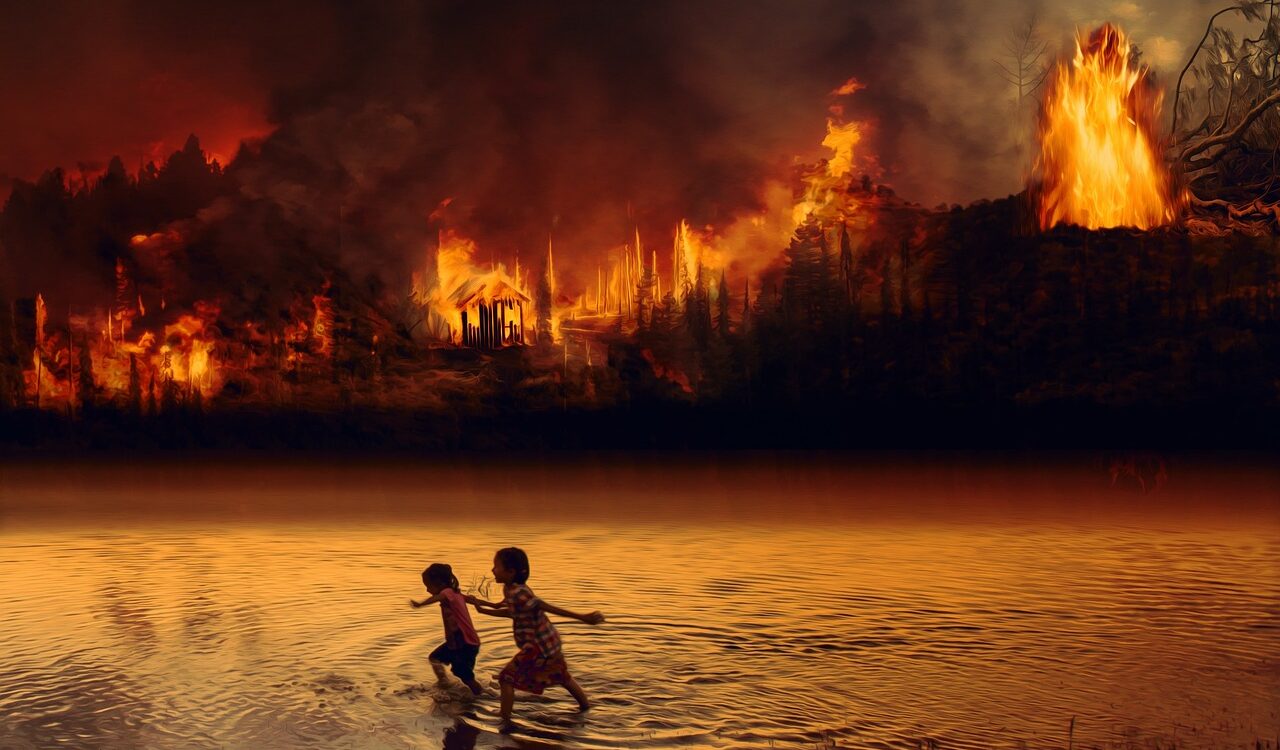Fires in the Amazon region pose a serious threat to local biodiversity, as well as human health and the global climate. These fires are often caused by human activities, such as deforestation and agricultural expansion, and can result in significant damage to natural ecosystems, including habitat destruction and loss of animal and plant species.
The Amazon region has been severely affected by fires in Brazil. According to data from the National Institute for Space Research (INPE), in 2023, 39.7% of all fires recorded across the country occurred in the Amazon, covering a large part of Brazilian biodiversity. Records show a significant increase in the number of fires in recent years in the region, with over 100,000 fires recorded in 2020, representing an increase of 33% from the previous year. In 2022, in the first 261 days, the fires recorded in the region already exceeded the total number recorded in the entire year of 2021. Unfortunately, many of these fires were started intentionally, often aiming to clear the land for agricultural and livestock expansion.

Fires can cause a series of negative effects on Amazonian biodiversity. When they occur in forested areas, fire can destroy entire ecosystems and lead to habitat loss. This can result in the extinction of animal and plant species, many of which are endemic to the region. In addition, ash resulting from fires can reduce soil quality, making it less conducive to plant and tree growth.
The effects of fires on biodiversity in the Amazon region are even more worrying when one considers the importance of the forest for the global climate. The Amazon is known as the “lungs of the world”, as it produces about 20% of the planet's oxygen and absorbs excess carbon dioxide. Fires release large amounts of greenhouse gases (GHG), including carbon dioxide and methane, contributing to increased global warming. In addition, ash from fires can reduce the quality of the soil, making it less suitable for the growth of plants and trees, further affecting the region's biodiversity.
Fires can also impact human life in the Amazon region, causing respiratory problems and increasing the risk of respiratory diseases. In addition, many indigenous and riverside communities depend on the forest for their subsistence, being economically and culturally affected by the fires.
In order to combat fires and their negative impacts, coordinated action between governments, non-governmental organizations and local communities is essential. This may include implementing effective public policies to combat illegal deforestation and the use of fire in agriculture, as well as protecting natural areas, creating incentives for sustainable development and engaging the local population in prevention and control actions. of fires.
Amazon is one of the most important biodiversity in the world
Fires in the Amazon can have impacts not only in the Amazon region, but also in other parts of the world. The Amazon rainforest is known as the “lungs of the world” for producing a large amount of oxygen and absorbing carbon dioxide from the atmosphere. Therefore, fires in the Amazon have a significant impact on air quality and global climate change.
The effects of the fires in the Amazon can be felt in other countries in South America, due to air pollution and climate changes that affect the climate and the environment in general. In addition, Amazonian biodiversity is important for the conservation of animal and plant species that can be found in other parts of the world, which means that the loss of biodiversity in the Amazon can have consequences at a global level.
The fires in the Amazon are a problem that directly affects the image of Brazil and its relationship with other countries. Deforestation and fires in the Amazon have been the target of criticism from international organizations and world leaders, which could affect the country's reputation and its commercial and diplomatic relations with other countries.
The issue of burning in the Amazon has been widely discussed in international environmental forums, especially at the United Nations (UN). The Amazon is considered one of the most important regions in the world in terms of biodiversity and plays a crucial role in the stability of the global climate. Therefore, fires and deforestation in the region are seen as a global concern.
The UN has been urging the Brazilian government to take more effective measures to fight fires and deforestation in the Amazon. UN Secretary-General António Guterres expressed concern about the situation in the Amazon region in 2019 due to the increase in the number of fires and deforestation in the region, which threatened biodiversity, the global climate and local communities. Guterres' statement came after a significant number of fires were recorded in the Amazon during the period, which raised global concern regarding the protection of the largest tropical forest in the world.
In addition, international environmental organizations draw attention to the importance of preserving the Amazon and the negative impacts of fires on biodiversity and the global climate. Pressure from public opinion and the international community has been fundamental to encourage the implementation of effective measures to fight fires and deforestation in the Amazon.
Government and community unite to preserve the Amazon biome
Fighting fires in the Amazon is a complex challenge, which requires the implementation of several coordinated actions. Some of the ongoing initiatives to combat fires in the region include:
Burning monitoring and alert programs: The National Institute for Space Research (INPE) and other institutions have developed burning monitoring systems, which allow the identification of areas at risk of fires and the sending of alerts to responsible authorities. These monitoring programs allow the identification and rapid response to fires, reducing their impacts.
Forest fire prevention and control programs: Fighting fires in the Amazon involves not only fire control, but also prevention and adequate management of forest areas. Many initiatives seek to promote sustainable land use, proper management of protected areas and the reduction of illegal deforestation, such as the “Adote 1 Parque” program. These programs aim to prevent and control fires in the region, in addition to promoting sustainable development and biodiversity conservation.
Enforcement and law enforcement: Strict enforcement of the law is critical to combating fires in the Amazon. This includes effectively enforcing illegal deforestation and burning activities, imposing fines and sanctions on those responsible, and strengthening the bodies responsible for environmental protection. Enforcement is an important way to prevent fires, and law enforcement is critical to ensuring the protection of the environment and local communities.
Engagement of civil society and local communities: The protection of the Amazon also depends on the engagement of civil society and local communities, which can contribute to the conservation of Amazonian biodiversity and the prevention of fires through awareness campaigns, environmental education and participation in initiatives sustainable management of natural resources. The participation of civil society is essential to promote the conservation of the Amazon and ensure that initiatives to combat fires are effective.
Local communities play a key role in the process of recovering areas devastated by fire in the Amazon. These communities often have in-depth knowledge of the forest and natural resources, and can significantly contribute to the restoration of ecosystems affected by fires.
One of the ways to involve local communities in the recovery process is through ecological restoration projects. These projects seek to promote the recovery of degraded areas and the restoration of ecosystems affected by fires, in addition to promoting the sustainable use of natural resources and the economic development of local communities.
Ecological restoration projects may include activities such as planting native species, building nurseries, producing seedlings, recovering springs and watercourses, and promoting agroecology and sustainable soil management practices. These activities can involve local communities in all stages of the process, from collecting seeds to planting and maintaining seedlings.
In addition, the participation of local communities can be encouraged through training programs and environmental education, which aim to raise awareness about the importance of conserving biodiversity and the sustainable use of natural resources. These programs can include courses, workshops and other activities that promote the knowledge and skills of local communities in managing natural resources and protecting the forest.
Perspectives and goals: a look to the future years
Currently, there is no specific international agreement with targets for reducing burning in the Amazon. However, the United Nations Framework Convention on Climate Change (UNFCCC) and the Paris Agreement establish global targets for reducing greenhouse gas emissions, which include emissions resulting from deforestation and burning in the Amazon and other tropical florests.
The Paris Agreement, for example, sets the goal of limiting the increase in global temperature to 1.5°C compared to pre-industrial levels. To reach this goal, the signatory countries of the agreement must reduce their greenhouse gas emissions, including emissions resulting from deforestation and fires.
The perspectives and goals for the future of fires in the Amazon involve the implementation of actions for prevention, monitoring, inspection and recovery of ecosystems affected by fires. Some of the key perspectives and goals include:
Reduction of deforestation rates: The reduction of illegal deforestation is fundamental for the reduction of fires in the Amazon. Brazil's goal is to reduce illegal deforestation by 90% by 2023, which can significantly contribute to reducing fires in the region.
Strengthening Enforcement and Law Enforcement: Strict law enforcement is critical to combating fires in the Amazon. The goal is to strengthen the bodies responsible for inspection and law enforcement and increase the number of operations to combat environmental crime in the region.
Investment in fire prevention and firefighting programs: Preventing and fighting forest fires are essential for reducing fires in the Amazon. The goal is to invest in fire prevention and firefighting programs, including the use of fire monitoring and warning technologies.
Engagement of civil society and local communities: The participation of civil society and local communities is essential for protecting the Amazon and reducing fires in the region. The goal is to promote environmental education, awareness and engagement of local communities in forest protection initiatives.
Restoration of degraded ecosystems: The recovery of ecosystems degraded by fire is essential for the conservation of Amazonian biodiversity. The goal is to promote the ecological restoration of degraded areas, including the participation of local communities in recovery projects for ecosystems affected by fires.
Fires in the Amazon pose a serious threat to biodiversity, the climate and local communities. The Amazon region has seen a significant increase in the number of fires in recent years, driven by deforestation and climate change. The solution to the problem involves the implementation of prevention, inspection, monitoring and recovery actions, in addition to engaging local communities and strengthening international cooperation. Protecting the Amazon and reducing fires are essential to guarantee a sustainable future for the region and the planet as a whole.




